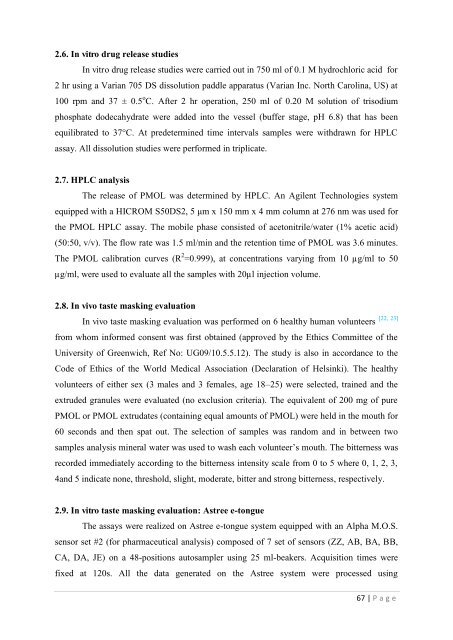Development of hot-melt extrusion as a novel technique for the ...
Development of hot-melt extrusion as a novel technique for the ...
Development of hot-melt extrusion as a novel technique for the ...
Create successful ePaper yourself
Turn your PDF publications into a flip-book with our unique Google optimized e-Paper software.
2.6. In vitro drug rele<strong>as</strong>e studiesIn vitro drug rele<strong>as</strong>e studies were carried out in 750 ml <strong>of</strong> 0.1 M hydrochloric acid <strong>for</strong>2 hr using a Varian 705 DS dissolution paddle apparatus (Varian Inc. North Carolina, US) at100 rpm and 37 ± 0.5 o C. After 2 hr operation, 250 ml <strong>of</strong> 0.20 M solution <strong>of</strong> trisodiumphosphate dodecahydrate were added into <strong>the</strong> vessel (buffer stage, pH 6.8) that h<strong>as</strong> beenequilibrated to 37°C. At predetermined time intervals samples were withdrawn <strong>for</strong> HPLC<strong>as</strong>say. All dissolution studies were per<strong>for</strong>med in triplicate.2.7. HPLC analysisThe rele<strong>as</strong>e <strong>of</strong> PMOL w<strong>as</strong> determined by HPLC. An Agilent Technologies systemequipped with a HICROM S50DS2, 5 m x 150 mm x 4 mm column at 276 nm w<strong>as</strong> used <strong>for</strong><strong>the</strong> PMOL HPLC <strong>as</strong>say. The mobile ph<strong>as</strong>e consisted <strong>of</strong> acetonitrile/water (1% acetic acid)(50:50, v/v). The flow rate w<strong>as</strong> 1.5 ml/min and <strong>the</strong> retention time <strong>of</strong> PMOL w<strong>as</strong> 3.6 minutes.The PMOL calibration curves (R 2 =0.999), at concentrations varying from 10 µg/ml to 50µg/ml, were used to evaluate all <strong>the</strong> samples with 20µl injection volume.2.8. In vivo t<strong>as</strong>te m<strong>as</strong>king evaluationIn vivo t<strong>as</strong>te m<strong>as</strong>king evaluation w<strong>as</strong> per<strong>for</strong>med on 6 healthy human volunteers[22, 23]from whom in<strong>for</strong>med consent w<strong>as</strong> first obtained (approved by <strong>the</strong> Ethics Committee <strong>of</strong> <strong>the</strong>University <strong>of</strong> Greenwich, Ref No: UG09/10.5.5.12). The study is also in accordance to <strong>the</strong>Code <strong>of</strong> Ethics <strong>of</strong> <strong>the</strong> World Medical Association (Declaration <strong>of</strong> Helsinki). The healthyvolunteers <strong>of</strong> ei<strong>the</strong>r sex (3 males and 3 females, age 18–25) were selected, trained and <strong>the</strong>extruded granules were evaluated (no exclusion criteria). The equivalent <strong>of</strong> 200 mg <strong>of</strong> purePMOL or PMOL extrudates (containing equal amounts <strong>of</strong> PMOL) were held in <strong>the</strong> mouth <strong>for</strong>60 seconds and <strong>the</strong>n spat out. The selection <strong>of</strong> samples w<strong>as</strong> random and in between twosamples analysis mineral water w<strong>as</strong> used to w<strong>as</strong>h each volunteer‘s mouth. The bitterness w<strong>as</strong>recorded immediately according to <strong>the</strong> bitterness intensity scale from 0 to 5 where 0, 1, 2, 3,4and 5 indicate none, threshold, slight, moderate, bitter and strong bitterness, respectively.2.9. In vitro t<strong>as</strong>te m<strong>as</strong>king evaluation: Astree e-tongueThe <strong>as</strong>says were realized on Astree e-tongue system equipped with an Alpha M.O.S.sensor set #2 (<strong>for</strong> pharmaceutical analysis) composed <strong>of</strong> 7 set <strong>of</strong> sensors (ZZ, AB, BA, BB,CA, DA, JE) on a 48-positions autosampler using 25 ml-beakers. Acquisition times werefixed at 120s. All <strong>the</strong> data generated on <strong>the</strong> Astree system were processed using67 | P a g e
















